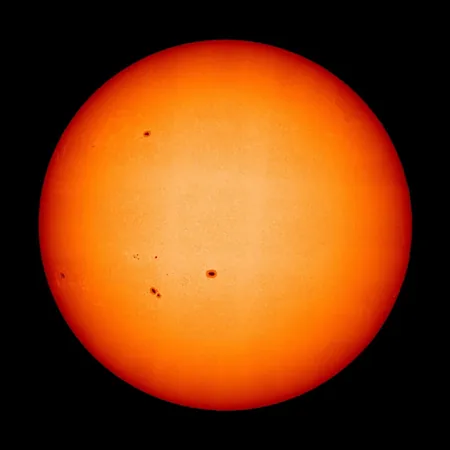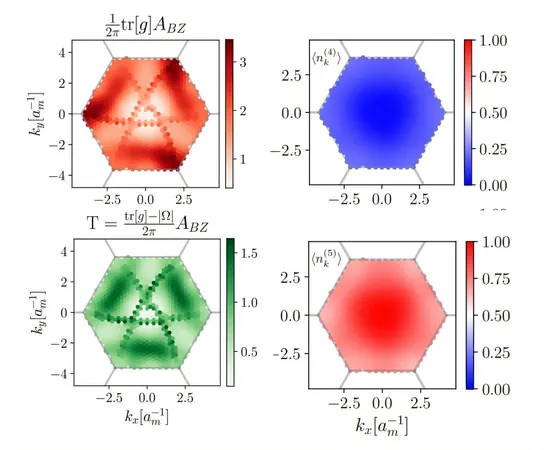
Unveiling the Sun: A Revolutionary High-Resolution Look at Our Star
2024-11-22
Author: Sophie
Introduction
Researchers from the Max Planck Institute for Solar System Research have achieved a groundbreaking milestone in solar observation by creating unprecedented high-resolution images of the entire solar disk. These stunning visuals stem from 25 individual frames captured by the European Space Agency's Solar Orbiter, showcasing our sun like never before.
Capturing the Solar Surface
In March 2023, the Solar Orbiter was situated approximately half the distance from the sun as Earth, making the solar disk too expansive to fit into a single image. The intricate surface of the sun can now be seen with astounding clarity, akin to the churning turbulence of boiling water. Plasma eruptions burst forth from below the surface, while dark sunspots signal areas with particularly intense magnetic fields.
Mission Overview
No celestial body in our solar system displays as much dynamism and complexity as the sun. In an ambitious mission that began in February 2020, the Solar Orbiter was equipped with six sophisticated instruments aimed at probing beneath the surface of our star. Notably, the Max Planck Institute supplied hardware for four of these instruments, enabling detailed analysis of solar activity.
Instrument Functionality
Instruments like the Extreme Ultraviolet Imager (EUI) focus on the sun’s hot outer atmosphere, while the Polarimetric and Helioseismic Imager (PHI) examines the visible surface, providing critical insights into the sun’s magnetic field strength and plasma velocity. Data released from observations on March 22, 2023, reveals intricate structures more vividly than ever before.
A Vision of the Sun’s Layers
According to Prof. Dr. Sami K. Solanki, director of MPS and the lead investigator for PHI, 'To understand the sun comprehensively, it's imperative to examine all its layers simultaneously with high resolution.' The Solar Orbiter’s unique elliptical trajectory allows it to repeatedly approach the sun within 42 million kilometers, facilitating these unparalleled observations.
Mosaic Construction
During an impressive close-up on March 22, 2023, with the sun 74 million kilometers away, the Solar Orbiter captured various segments of the sun over several hours. To create a full-disk mosaic, researchers meticulously combined these images, keenly aware that vital data about the sun's magnetic fields is often contained in just a sliver of the captured light.
Challenges in Data Transmission
However, challenges arise from the considerable distance to Earth and a restricted data transmission rate. As a result, the immense volumes of data sometimes take months to arrive back on Earth. Despite this, the PHI team anticipates further high-resolution solar images about twice a year, enhancing our understanding of solar dynamics.
In-Depth Discovery and Insights
Today's released full-disk images contain a resolution of approximately 175 kilometers per pixel. While this may not match the detail achieved by ground-based telescopes like the Gregor solar telescope, which can resolve structures down to 50 kilometers per pixel, it provides a comprehensive picture unavailable from Earth due to atmospheric interference.
Solar Surface Patterns
Magnificent details emerge from a closer look at the sun. The surface displays a granulated pattern, reflecting the rise and fall of hot plasma—akin to what is observed in boiling water. Sunspots, which appear darker, are critical areas where the sun’s magnetic fields are notably stronger, inhibiting the rise of hot plasma.
Understanding the Solar Cycle
The data garnered from Solar Orbiter will help elucidate the sun's complex magnetic field and the underlying mechanisms behind its 11-year solar cycle. This cycle is characterized by fluctuations in solar activity, including increased sunspots and solar flares, experiencing heightened intensity every eleven years due to the interplay of plasma dynamics and magnetic field interactions.
Magnetic Field Dynamics
As the sun rotates, it distorts its magnetic field, creating a complex configuration of energy loops above sunspots. This chaotic activity can also lead to ejections of solar plasma, manifesting in vibrant auroras when these charged particles interact with Earth’s magnetic field.
Conclusion and Future Outlook
An exciting chapter is unfolding in our understanding of the sun, driven by these revolutionary images from Solar Orbiter. As scientists continue to unravel the intricate workings of our closest star, knowledge of its impacts on space weather, climate patterns, and even technology here on Earth is expected to grow substantially.
Stay tuned for more updates as we delve deeper into the sun's mysteries—our world might not be as far removed from this stellar fireball as we once thought!









 Brasil (PT)
Brasil (PT)
 Canada (EN)
Canada (EN)
 Chile (ES)
Chile (ES)
 España (ES)
España (ES)
 France (FR)
France (FR)
 Hong Kong (EN)
Hong Kong (EN)
 Italia (IT)
Italia (IT)
 日本 (JA)
日本 (JA)
 Magyarország (HU)
Magyarország (HU)
 Norge (NO)
Norge (NO)
 Polska (PL)
Polska (PL)
 Schweiz (DE)
Schweiz (DE)
 Singapore (EN)
Singapore (EN)
 Sverige (SV)
Sverige (SV)
 Suomi (FI)
Suomi (FI)
 Türkiye (TR)
Türkiye (TR)